本文简单对比了随机森林与GBDT模型的优缺点,并列举了两种模型的样例的模型效果
随机森林(Random Forest)
- 随机森林指的是利用多棵树对样本进行训练并预测的一种分类器,随机森林的每一棵决策树之间是没有关联的
优缺点
优点
- 在数据集上表现良好
- 方差和偏差都比较低,泛化性能优越
- 在创建随机森林的时候,对generlization error使用的是无偏估计
- 它能够处理很高维度(feature很多)的数据,并且不用做特征选择
- 在训练完后,能够输出特征(feature)的重要性程度,非常实用
- 高度并行化,易于分布式实现,训练速度快
- 在训练过程中,能够检测到feature间的互相影响
- 由于是树模型 ,不需要归一化即可之间使用,实现比较简单
缺点
|
|
查看数据情况(数据清洗过程已忽略)
|
|
| Var1 | Var2 | Var3 | Var4 | Var5 | Var6 | Var7 | Var8 | Var9 | Var10 | … | Var36 | Var37 | Var38 | Var39 | Var40 | Var41 | Var42 | Var43 | Var44 | tag_y | |
|---|---|---|---|---|---|---|---|---|---|---|---|---|---|---|---|---|---|---|---|---|---|
| 0 | 1 | -1 | -1 | -1 | 3 | 703 | -1 | -1 | -1 | 1 | … | 0 | 0 | 1 | 0 | 0 | 1 | 11 | 37 | 0 | 0 |
| 1 | 1 | -1 | -1 | -1 | 3 | 57 | 2 | 51 | 91 | 2 | … | 0 | 1 | 1 | 0 | 0 | 0 | 11 | 46 | 1 | 0 |
| 2 | 1 | 3 | 0 | -1 | 3 | 815 | 2 | 51 | -1 | 1 | … | 0 | 1 | 0 | 0 | 0 | 1 | 11 | 40 | 1 | 0 |
| 3 | 1 | -1 | -1 | 5 | 3 | 354 | 2 | 51 | 90 | 1 | … | 0 | 1 | 0 | 0 | 0 | 1 | 11 | 39 | 0 | 0 |
| 4 | 3 | -1 | -1 | -1 | 3 | 391 | 1 | 61 | 90 | 1 | … | 0 | 0 | 0 | 0 | 1 | 1 | 11 | 37 | 1 | 0 |
5 rows × 45 columns
|
|

变量相关性检验
|
|
| 变量 | 相关系数 | 相关系数绝对值 | |
|---|---|---|---|
| 44 | tag_y | 1.000000 | 1.000000 |
| 23 | Var24 | -0.387025 | 0.387025 |
| 16 | Var17 | 0.210136 | 0.210136 |
| 27 | Var28 | -0.157304 | 0.157304 |
| 22 | Var23 | -0.150241 | 0.150241 |
| 15 | Var16 | -0.095761 | 0.095761 |
| 20 | Var21 | 0.083199 | 0.083199 |
| 2 | Var3 | -0.082515 | 0.082515 |
| 17 | Var18 | -0.081642 | 0.081642 |
| 25 | Var26 | -0.080799 | 0.080799 |
| 24 | Var25 | -0.080647 | 0.080647 |
| 1 | Var2 | -0.068508 | 0.068508 |
| 12 | Var13 | -0.066173 | 0.066173 |
| 30 | Var31 | -0.063315 | 0.063315 |
| 0 | Var1 | 0.062513 | 0.062513 |
| 13 | Var14 | -0.058684 | 0.058684 |
| 18 | Var19 | 0.055990 | 0.055990 |
| 7 | Var8 | -0.055442 | 0.055442 |
| 40 | Var41 | 0.051801 | 0.051801 |
| 39 | Var40 | 0.050829 | 0.050829 |
| 31 | Var32 | 0.044908 | 0.044908 |
| 36 | Var37 | -0.042666 | 0.042666 |
| 28 | Var29 | 0.042470 | 0.042470 |
| 42 | Var43 | 0.042357 | 0.042357 |
| 33 | Var34 | -0.033433 | 0.033433 |
| 34 | Var35 | -0.031154 | 0.031154 |
| 32 | Var33 | 0.029990 | 0.029990 |
| 11 | Var12 | -0.025125 | 0.025125 |
| 14 | Var15 | 0.024673 | 0.024673 |
| 9 | Var10 | 0.023796 | 0.023796 |
| 3 | Var4 | -0.017289 | 0.017289 |
| 5 | Var6 | -0.016744 | 0.016744 |
| 37 | Var38 | -0.016197 | 0.016197 |
| 10 | Var11 | 0.015352 | 0.015352 |
| 4 | Var5 | 0.014266 | 0.014266 |
| 6 | Var7 | -0.013188 | 0.013188 |
| 19 | Var20 | -0.013174 | 0.013174 |
| 41 | Var42 | -0.012301 | 0.012301 |
| 21 | Var22 | -0.010746 | 0.010746 |
| 8 | Var9 | 0.010663 | 0.010663 |
| 35 | Var36 | 0.009791 | 0.009791 |
| 43 | Var44 | -0.006633 | 0.006633 |
| 26 | Var27 | -0.004636 | 0.004636 |
| 29 | Var30 | 0.002331 | 0.002331 |
| 38 | Var39 | -0.000359 | 0.000359 |
随机森林建模
|
|
0.67633816908454225
|
|
| dummy_variable | importance | |
|---|---|---|
| 23 | Var24 | 0.435 |
| 16 | Var17 | 0.127 |
| 15 | Var16 | 0.090 |
| 27 | Var28 | 0.076 |
| 22 | Var23 | 0.053 |
| 13 | Var14 | 0.024 |
| 17 | Var18 | 0.021 |
| 25 | Var26 | 0.020 |
| 20 | Var21 | 0.019 |
| 5 | Var6 | 0.016 |
| 26 | Var27 | 0.014 |
| 42 | Var43 | 0.012 |
| 30 | Var31 | 0.010 |
| 2 | Var3 | 0.009 |
| 41 | Var42 | 0.007 |
| 8 | Var9 | 0.006 |
| 0 | Var1 | 0.006 |
| 7 | Var8 | 0.006 |
| 1 | Var2 | 0.005 |
| 18 | Var19 | 0.004 |
| 28 | Var29 | 0.004 |
| 3 | Var4 | 0.004 |
| 12 | Var13 | 0.004 |
| 11 | Var12 | 0.003 |
| 39 | Var40 | 0.003 |
| 24 | Var25 | 0.003 |
| 6 | Var7 | 0.003 |
| 14 | Var15 | 0.003 |
| 10 | Var11 | 0.003 |
| 21 | Var22 | 0.003 |
| 40 | Var41 | 0.002 |
| 36 | Var37 | 0.002 |
| 33 | Var34 | 0.001 |
| 9 | Var10 | 0.001 |
| 29 | Var30 | 0.000 |
| 43 | Var44 | 0.000 |
| 31 | Var32 | 0.000 |
| 37 | Var38 | 0.000 |
| 34 | Var35 | 0.000 |
| 32 | Var33 | 0.000 |
| 35 | Var36 | 0.000 |
| 38 | Var39 | 0.000 |
| 4 | Var5 | 0.000 |
| 19 | Var20 | 0.000 |
|
|
AUC值和ROC曲线
|
|
0.79153905777374467
|
|
|
|

K-S值和K-S曲线
|
|
0.47769207501512401
|
|
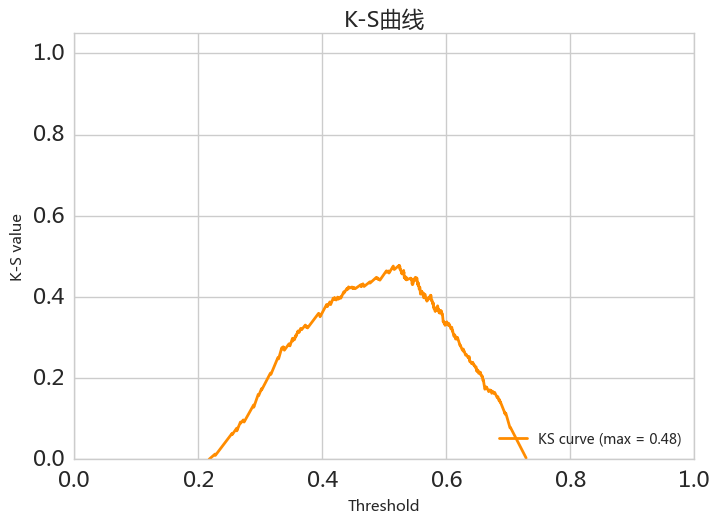
PRC曲线与f1_score曲线
|
|
|
|
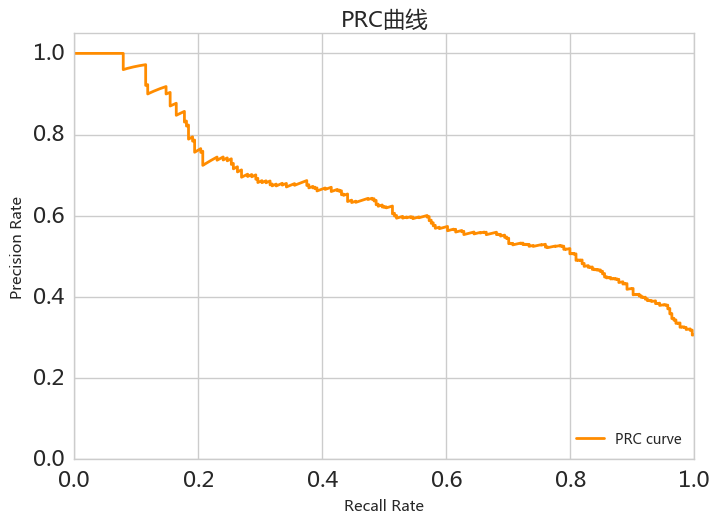
|
|

|
|
0.63074901445466491
阈值与留存
|
|
|
|

梯度提升树GBDT (Gradient Boosting Decision Tree)
简介/备注
- GBDT的树都是回归树,而不是分类树,GBDT 是多棵树的输出预测值的累加
- 在Gradient Boost中,每个新的模型的建立是为了使得之前模型的残差往梯度方向减少
- GDBT 由损失函数和正则化函数两部分构成:
- 损失函数尽可能的小,这样使得目标函数能够尽可能的符合样本
- 正则化函数防止模型过拟合
- 寻求损失函数和正则化函数的平衡点
- Feature 分裂原则:
- 遍历所有Feature,找到每个Feature的增益最大的分裂点,并计算出每个Feature分裂点的增益
- 取所有Feature分裂点的增益最大的Feature作为最先分裂点
- 使用贪婪法,重复上面的过程,建立一棵完整的决策树
- 每次分裂的目的是为了获得更多的信息增益,如果分裂后信息增益为负数,则停止分裂
优缺点
优点
- 预测精度高
- 能处理非线性数据、多特征类型
- 适合低维稠密数据
- 可以灵活处理各种类型的数据,包括连续值和离散值,不需要做特征的归一化
- 在相对少的调参时间情况下,预测的准备率也可以比较高
- 使用一些健壮的损失函数,对异常值的鲁棒性非常强
缺点
- 弱学习器之间存在依赖关系,难以并行训练数据,是个串行的过程
- 计算复杂度大
- 不使用高维稀疏特征
gbdt使用什么损失函数?比如 Huber损失函数和Quantile损失函数;均方误差和LogLoss等
代码样例
|
|
GBDT建模
|
|
GradientBoostingClassifier(criterion='friedman_mse', init=None,
learning_rate=0.1, loss='deviance', max_depth=4,
max_features=5, max_leaf_nodes=None,
min_impurity_split=1e-07, min_samples_leaf=100,
min_samples_split=2, min_weight_fraction_leaf=0.0,
n_estimators=100, presort='auto', random_state=33,
subsample=1.0, verbose=0, warm_start=False)
算法评估指标
|
|
| col_0 | 0 | 1 |
|---|---|---|
| row_0 | ||
| 0 | 629 | 67 |
| 1 | 147 | 157 |
|
|
precision recall f1-score support
0 0.8106 0.9037 0.8546 696
1 0.7009 0.5164 0.5947 304
avg / total 0.7772 0.7860 0.7756 1000
ROC曲线
|
|
0.81887571839080453
|
|
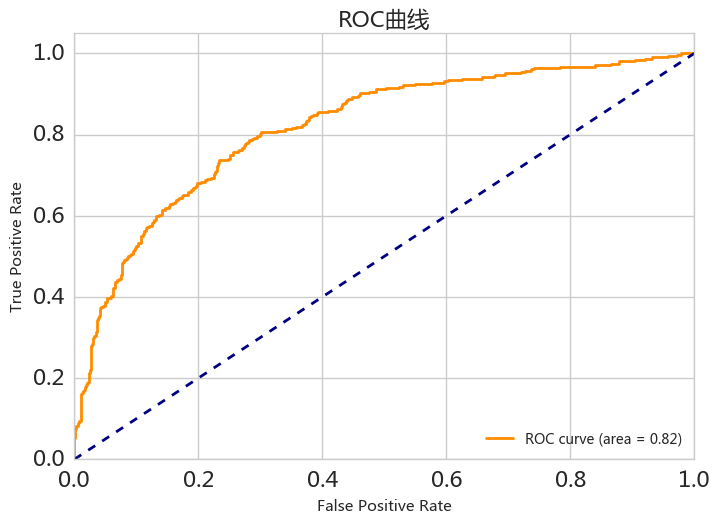
K-S值和K-S曲线
|
|
0.50457501512401692
|
|
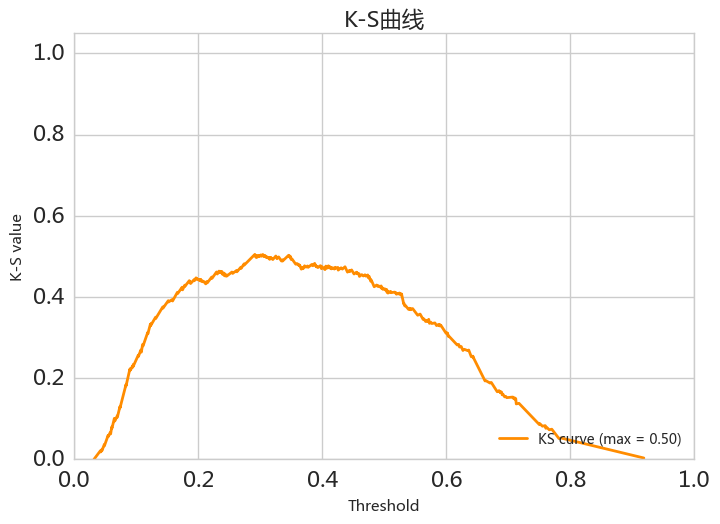
PRC曲线与f1_score曲线
|
|
|
|
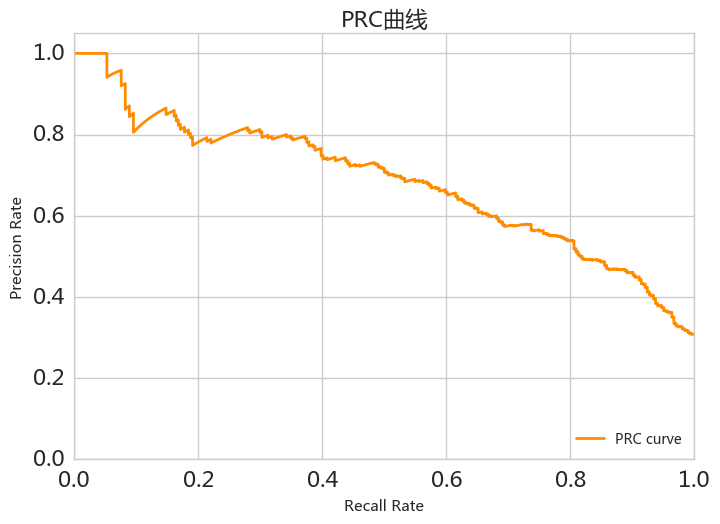
|
|
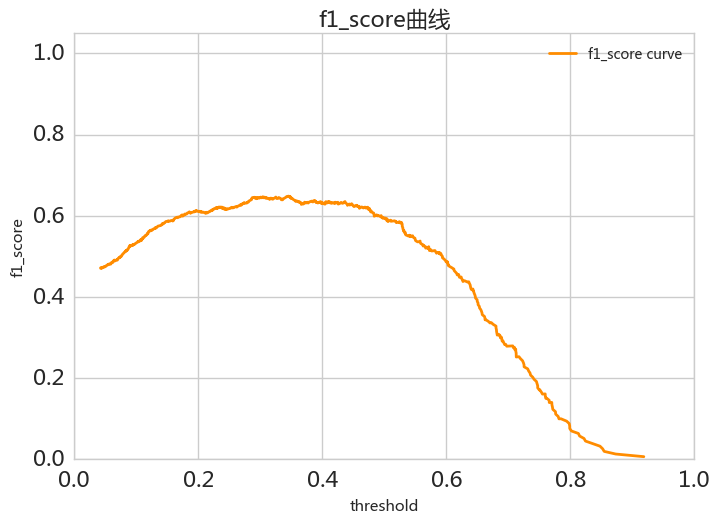
阈值选取问题
|
|
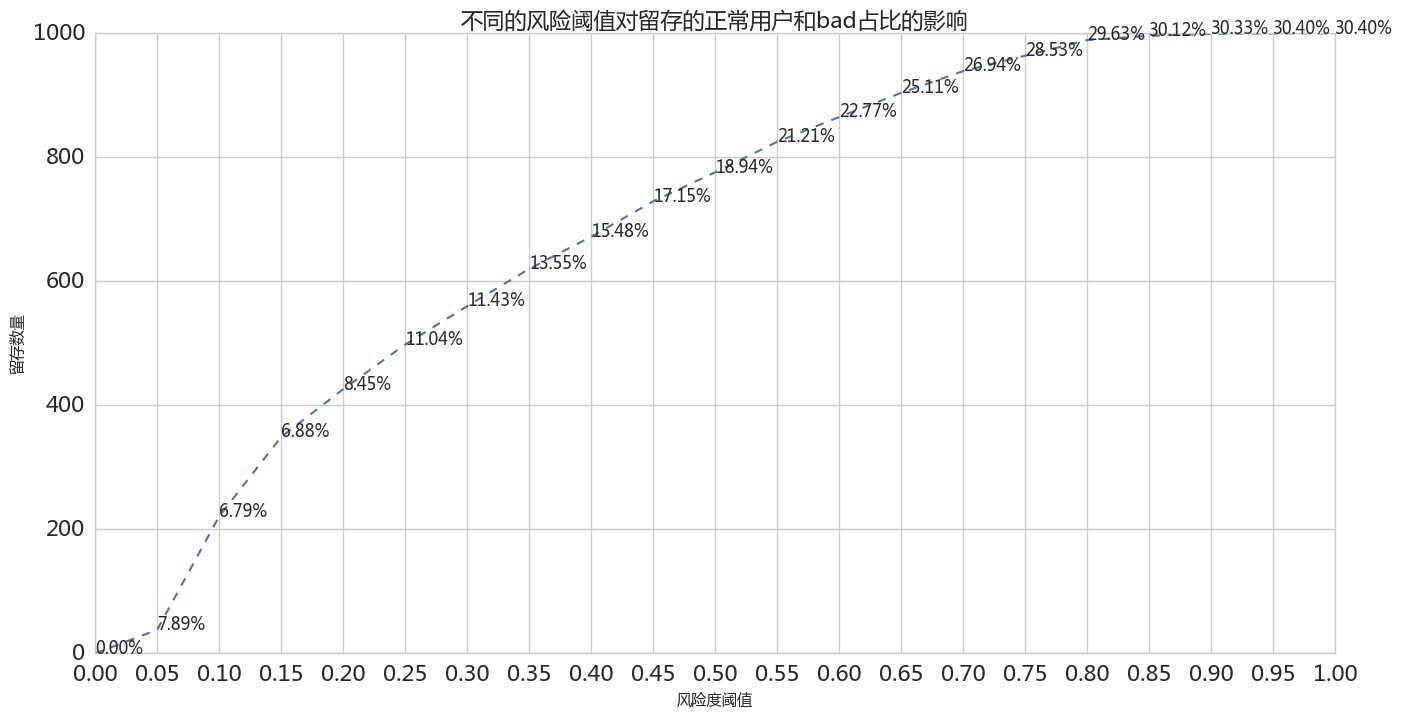
自动调参
|
|
GridSearchCV(cv=sklearn.cross_validation.StratifiedKFold(labels=[0 1 ..., 1 0], n_folds=10, shuffle=False, random_state=None),
error_score='raise',
estimator=GradientBoostingClassifier(criterion='friedman_mse', init=None,
learning_rate=0.1, loss='deviance', max_depth=3,
max_features=None, max_leaf_nodes=None,
min_impurity_split=1e-07, min_samples_leaf=1,
min_samples_split=2, min_weight_fraction_leaf=0.0,
n_estimators=100, presort='auto', random_state=None,
subsample=1.0, verbose=0, warm_start=False),
fit_params={}, iid=True, n_jobs=1,
param_grid={'n_estimators': [100, 300, 500, 1000], 'max_depth': [2, 3, 4, 5], 'max_features': [1, 3, 5, 7, 9]},
pre_dispatch='2*n_jobs', refit=True, scoring='accuracy', verbose=0)
|
|
0.7763881940970485
|
|
{'max_depth': 5, 'max_features': 9, 'n_estimators': 100}